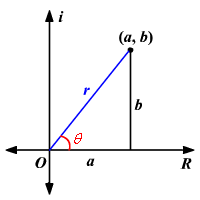Convert From Complex To Polar
- Home
Polar Form of a Complex Number
The polar form of a circuitous number is another manner to correspond a complex number. The form is called the rectangular coordinate class of a complex number.

The horizontal centrality is the existent centrality and the vertical axis is the imaginary axis. Nosotros detect the real and complex components in terms of and where is the length of the vector and is the angle made with the real axis.
From Pythagorean Theorem :
Past using the bones trigonometric ratios :
and .
Multiplying each side past :
The rectangular form of a circuitous number is given past
.
Substitute the values of and .
In the case of a complex number, represents the absolute value or modulus and the angle is chosen the argument of the complex number.
This can be summarized every bit follows:
The polar form of a complex number is , where , , and for and or for .
Instance:
Limited the complex number in polar form.
The polar class of a complex number is .
And then, first find the absolute value of .
Now find the argument .
Since , use the formula .
Notation that hither is measured in radians.
Therefore, the polar form of is nearly .
Convert From Complex To Polar,
Source: https://www.varsitytutors.com/hotmath/hotmath_help/topics/polar-form-of-a-complex-number
Posted by: sumterhorged.blogspot.com


0 Response to "Convert From Complex To Polar"
Post a Comment